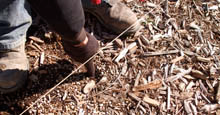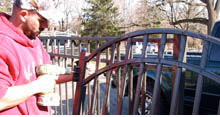Tools and Supplies Needed:
- Post Hole Digger or Power Auger
- 100′ tape measure
- Level
- String Line & Wood or Metal Stakes
- Hacksaw or Reciprocating Saw
- Screw Gun and Phillips Bit
- Rubber mallet
- 2” Wooden Blocks
- Cement mix
*The material contained herein is for general installation information only and is not intended as a complete manual on fence installation. Ultra Aluminum Mfg. Inc is not responsible for any errors or omissions made by the installer of the fence. If you have any doubts about your ability to install your fence, we suggest that you hire a professional, experienced fence installation company to do the job for you.
Remember to measure twice and cut once…you’ll be glad you did!”
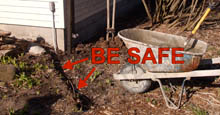
Identify underground utility lines:
Be sure that all potential underground utility lines
have been identified and marked by the utility
company. This can be a life and death matter!
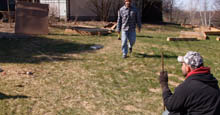 Be aware of property lines:
Be aware of property lines:
Be sure that you are aware of your property lines. If
you are not certain about your property lines, it is
advisable to have your property surveyed before
installing a fence. You are ultimately liable for its
location!
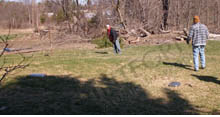 Walk the area:
Walk the area:
Walk the area to be fenced. Check for pool equipment
and utility lines. Typically, a utility company does not
mark private underground lines. If you are not 100%
certain, contact your pool installer for assistance (it’s
a good idea to have him mark all underground lines).
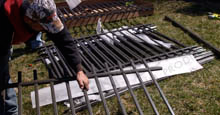
Unpack and review packing list
Unpack boxes and crosscheck all of your materials
with your packing list. Doing this will ensure that
everything that you need is present.
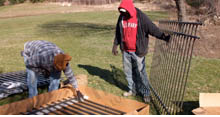 Earmark types of panels
Earmark types of panels
If there are areas with a grade slope, identify and
earmark your rackable panels for use in these areas
before you begin. These will have wider holes for the
pickets to go through.
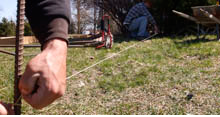 String the line
String the line
You are now ready to begin. First, hammer wood (or
metal) stakes into place and run a string along the
entire line of fence. This string plays a critical role in
making sure your fence is straight. Make it taut.
Mark where to dig your post holes
Mark the location of the post holes on-center. The
key to running a straight and true fence is for the post
holes to line up with the string line. Use 72 1/2” oncenter
measurements for installing 6′ wide panels of
Residential or Commercial Grade fences with 2”
posts. Adjust accordingly for wider or narrower
panels. Some accessories may change the length of apanel, so always double check
measurements or call your Ultra representative for information. Don’t worry if you
run into spacing problems. Any fence panel may be cut to fit.
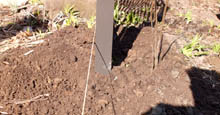 The string will be your guide
The string will be your guide
The string you have already staked out will be your
straight edge reference point until your project is
completed! You will place all of your posts about
1/4 inch to 1 inch from the taut string. It doesn’t
matter what you decide. It matters that you stay
consistent. IMPORTANT: Never let a post (or
anything) touch or push against your string, otherwise you will interfere with the
continuity of your fence line.
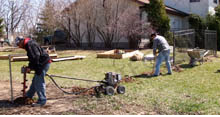 Dig a few holes at a time
Dig a few holes at a time
Dig 6” wide holes between 36” to 42” deep,
depending on your part of the country. Set your post
in the hole. Generally, your first post should be at a
termination point, such as up against your house. You
do not have to pre-dig all of your holes. It is okay –
better, in fact – to dig as-you-go, perhaps just a few
extra holes at a time. It’s a good idea to install your gate posts first. With your posts installed
plumb and true, the setting concrete will better support the fence panels. Just remember to
check on them to be sure they remain perfectly positioned and level until the concrete sets.
If they are out of position, the gate may not function.
 Installing a panel is quick and easy
Installing a panel is quick and easy
Start by attaching one section of fence to the post by
sliding the notched horizontal rails of the fence panel
into the punched holes of the post. Then put a 1” self
tapping screw into the pre-drilled pilot hole to
securely attach rail to post.
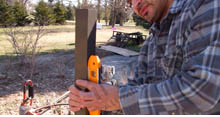 Always level each post
Always level each post
Level each post and pour your mixed concrete into
the hole. Posts should always be leveled off of your
string line reference point. Never jump ahead. Always
place one panel and one post at a time. Leave the
concrete 3-4” below grade. Place some dirt on top of
the hole and pack it tight. This will help hold the
fence level. Place a 2” block under the fence panel to hold it at a consistent 2” above grade.
For this, you can use pieces of wood or paver bricks.
 Set the gate opening
Set the gate opening
For staking out your gate, follow these
recommendations: The width of a gate refers to the
width of the opening between the gate posts (inside to-
inside, not distance on-center). If you have a 4′
single gate, set posts for a 4′ opening. If you have a
double gate, set the opening according to the gate
size. For example, if you have an 8′ double gate, set posts for an 8′ opening. The gate should
swing out and away from area to be enclosed by fence. Always make sure that you have
clearance to completely open the gate without obstruction.
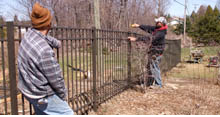
Go back and adjust (if needed)
As you move along, go back and level the already
installed panels. Posts may shift until the concrete has
set.
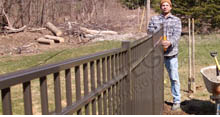 Use your sight to determine adjustments
Use your sight to determine adjustments
Using your sight, a level, and the reference point
string, ”tweak” the posts in and out and up and down.
If you are following the grade, stand back along the
fence and adjust the fence up or down to flow with
the grade.
 Corner Posts
Corner Posts
If your line ends with a corner, the horizontal rails of
the next panel must be notched to fit the post. If you
have to cut a panel to length, you must cut a ¾” long
x ¼” tall notch in the rail to fit into the post.
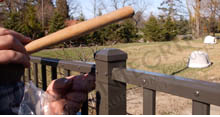 Snap the caps into place
Snap the caps into place
When all panels have been installed and cement
around posts is fully set, install the post caps by
snapping them into place. They do not require
screws! A rubber mallet may be helpful but is not
absolutely necessary. Just be careful.
Time for the gate
After you have installed all of your fence panels and
have leveled the gate posts, it’s time to hang the gates.

Preparing to attach the gate
After you make sure your gate posts are level and the
cement is fully set, confirm the direction of the swing
and bring in the gate.
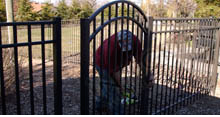 Install the hinges
Install the hinges
Install hinges on the gate posts first. Use 1” long self
tapping screws. Center the gate in the opening and
put only one screw in each hinge. This is to allow for
some final adjustment. If installing self-closing
hinges, adjust tension in the hinges for a proper swing rate.
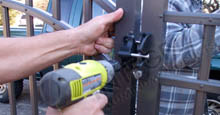
Install the gate latch
Now install the gate latch per the included
instructions.

Putting in the remaining screws
If the gate swings properly, put the remaining screws
in the hinges. Do not use the gate until the cement
fully sets. YOU ARE DONE!


